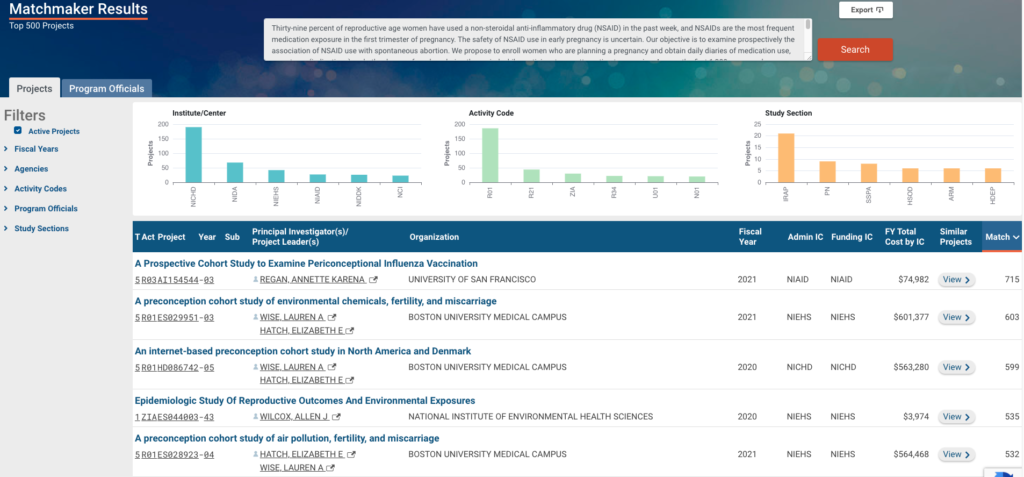Discover What’s Getting Funded with NIH Matchmaker

To compete well for grants, you need to know what’s getting funded. Enter NIH Matchmaker. The service takes text about your science and shows you the projects that are most like yours. Reading the abstracts yields insight into the kinds of aims reviewers find attractive, and the study section and institute that most commonly fund your kind of science.
Matchmaker lives within the larger NIH Reporter site. You’ll see a text box to enter any content you want to match on. The character limit is 15,000, so not only could you use the abstract of a grant or conference presentation, but also almost an entire manuscript, a dissertation chapter, or similar. Some researchers hack the matchmaking algorithm by putting in a list of words related to their research, repeating the more important ones several times. (I.e., “fibroids fibroids fibroids leiomyomata miscarriage pregnancy ultrasound ultrasound.”) Once you’ve entered your text, choose “Similar Projects.” (Can also check what comes up under “Similar Program Officials.”)
Matchmaker then returns up to 500 similar projects, listed in decreasing similarity (as indicated by the match score on the left). NIH provides info on how they calculate a match score (natural language processing using a combination of how frequently the term appears in the matched grant’s title, abstract, and aims, and how uncommon the word is across all grants). Click on “About RePORTER Data” and scroll to the bottom of that section.
Click on any project title to read the abstract, which typically provides a glimpse of the specific aims. Using the tabs at the top, you can see how much money the project received, which institute, program officer and study section it went through, and, if the project is far enough along, a list of papers linked to that particular grant.
Filter your results by any combination of institute, grant type (aka activity code), or study section using the bar graphs at the top of the results page. For example, in the results on the right, if you only wanted to see R01s funded by NICHD, you would click those two bars of the graphs. If you’re trying to decide between study sections to request, you can examine which grants on your match list have been funded by each of the study sections you’re considering by using the filters. (Guide to study section abbreviations.)
All of this information helps you reality check the attractiveness of the potential focus of your new grant and tailor your science and methods. This helps best align your grant application with the leading edge that NIH is funding right now–and when paylines are tight, you have to write what gets reviewers excited.
Additional Resources
Harness the Immense Power of Nosiness in NIH RePORTER
Using NIH RePORTER to Find Your Guide
Which Study Section Should I Pick? Try the Assisted Referral Tool!
Video: How to Use NIH Matchmaker







2 Comments
[…] Discover What’s Getting Funded with NIH Matchmaker […]